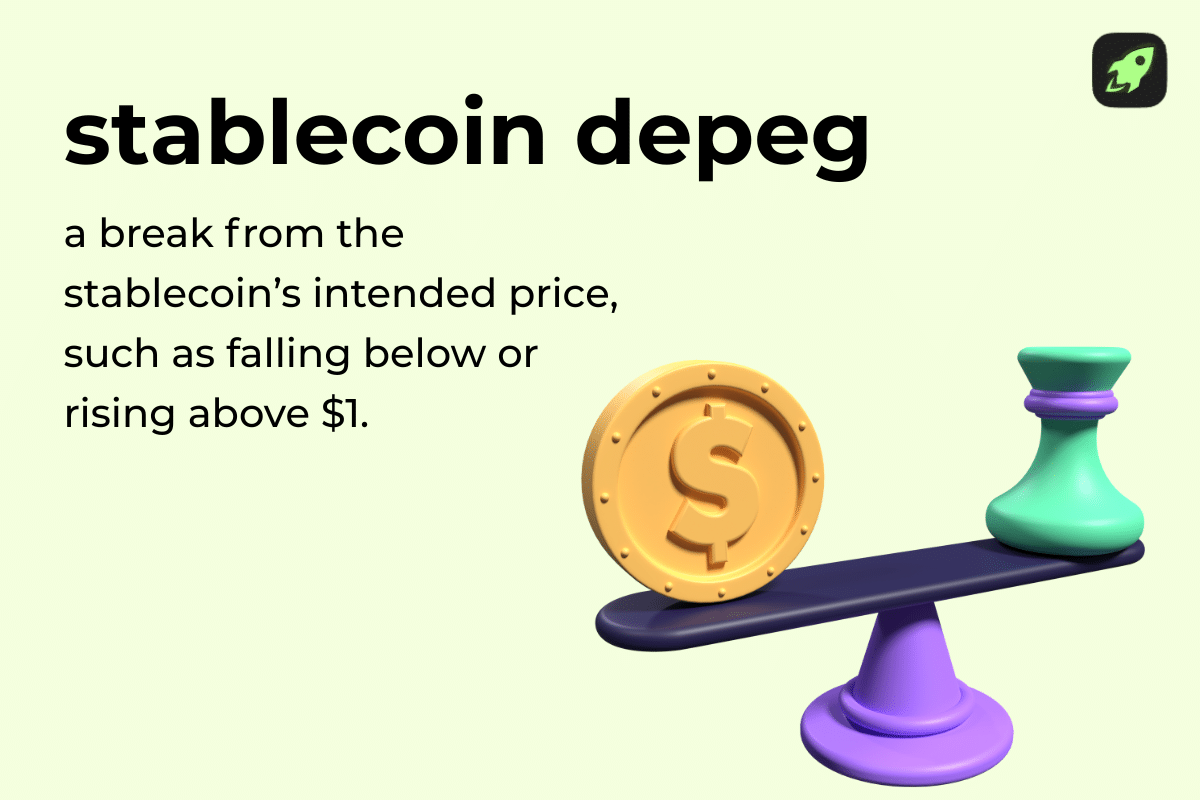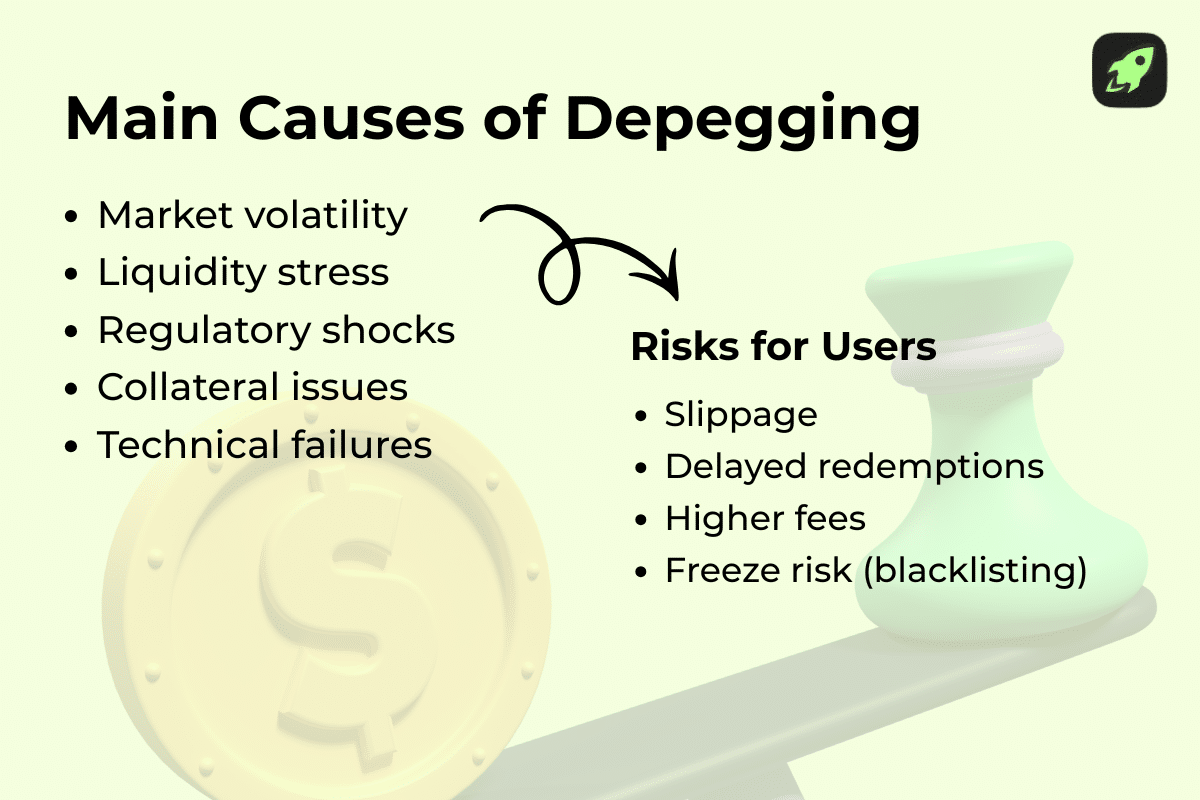A stablecoin is a token whose value is backed by stable assets such as gold or fiat currency. Because of this, their price usually remains equal to 1 US dollar or an ounce of gold, respectively. In a fast and volatile crypto market, where other cryptocurrencies can quickly rise or fall, stability is highly appreciated. But just like physical money, crypto coins aren’t invulnerable. Every once in a while, even stablecoins can depeg.
Knowing what is depegging and how it happens can help you prepare and prevent significant losses.
Table of Contents
What is a Stablecoin Depeg?
A stablecoin depeg happens when the coin’s price drops or rises far from the value it’s meant to stay equal to, like when a $1 fiat-backed stablecoin no longer stays close to $1.

One of the biggest reasons people use stablecoins is that they’re designed to maintain stable value. So, when a depeg event happens, it can cause serious problems. Investors may lose money, and trust in the coin or even the wider crypto market can quickly drop.
A depeg can be temporary or permanent, depending on what caused it and what type of stablecoin it is. For example, fiat-backed stablecoins might depeg due to banking or liquidity issues, while crypto-collateralized and algorithmic stablecoins often struggle during extreme market conditions or design flaws.
Understanding why a stablecoin depegs is crucial. The cause helps investors decide whether the coin can recover or if it’s safer to sell their digital assets.
Why do Stablecoins Depeg?
Several factors can cause the stablecoin price to fluctuate. They often depend on the type of coin and external influence. To understand why do stablecoins depeg, we will take a deep dive into the potential risks.
Market Fluctuations
- The cryptocurrency market is highly volatile, so sudden changes in popularity can push stablecoin prices up or down.
- Market sentiment (fear or hype) can trigger mass buying or selling of digital assets.
- Liquidity issues can arise during market stress, making it harder to keep the peg.
- External events or speculation can impact stability, especially with algorithmic or fractional-algorithmic stablecoins like FRAX.
Regulatory Actions
- Government policies or changes to crypto rules can create uncertainty.
- Stricter reserve requirements may affect how stablecoins are backed.
- Negative regulatory news can quickly lower confidence and cause price drops, changing the market dynamics.
Technical Vulnerabilities
- Smart contract bugs or security breaches can lead to loss of funds and external attacks.
- Platform failures or poor management can disrupt access to stablecoins.
- Lack of transparency reduces user trust.
Collateral Management
- A pegged cryptocurrency must hold reliable backing assets (like cash or crypto).
- If these assets are volatile or illiquid, the peg can fail.
- Regular audits and transparent reporting help build confidence among market participants.
Market Manipulation
- Malicious actors may use tactics like wash trading or spoofing to distort prices.
- Weak regulation allows manipulation to happen more easily, shaking market confidence in the process.
- In decentralized finance, transparency and community oversight are key to preventing abuse.

How Stablecoins Try to Maintain the Peg
To function properly, stablecoins have to maintain their peg to assets. To achieve that, different coins have to implement different measures. Here are several examples.
Redemption Mechanism
A redemption mechanism helps keep the price of an exchange-traded fund close to its true value. When a stablecoin’s market price moves above or below its actual net asset value, authorized participants (usually large broker-dealers) step in to profit from the difference. They buy or sell еру stablecoin’s shares and the underlying assets until prices align again. This process, called arbitrage, restores the coin’s fair value. By adding or removing shares based on market demand, the redemption mechanism keeps stablecoins efficient, closely tied to the asset, and fairly priced for all investors.
Mint-and-Burn
When a stablecoin is created (minted), the issuer first sends new tokens to its own wallet, then transfers them to users. When coins are burned, they’re moved to a special wallet so they can’t be used again.
Many users don’t mint new coins directly, they simply buy or trade existing ones on crypto exchanges, which doesn’t change the total token supply.
Minting and burning keep the circulating supply equal to the issuer’s cash reserves, ensuring stability. However, mistakes can happen, like in October, 2025, when Paxos accidentally minted $300 trillion in PayPal’s PYUSD due to a technical error.
Arbitrage
Arbitrage is a key idea that helps stablecoins stay close to their 1 US dollar value. If a stablecoin drops to $0.98, traders buy it cheaply and redeem it for $1 in collateral, reducing the number of coins in circulation. If it rises to $1.02, traders mint new coins and sell them for a small profit, increasing supply. These actions quickly push the price back toward $1. This process uses natural market incentives to keep stablecoins stable. In short, traders’ rational behavior automatically balances supply and demand, helping the coin maintain its peg over time.

How to Get Free Crypto
Simple tricks to build a profitable portfolio at zero cost

Rebase Mechanism
A rebase mechanism is a system often used by algorithmic stablecoins. It automatically changes the number of stablecoins in circulation to keep the price close to 1 US dollar. Instead of being backed by real assets, it uses algorithms and smart contracts to adjust supply.
If the price goes above 1 US dollar, the system creates (mints) more coins and adds them to holders’ wallets, increasing supply and pushing the price down. If the price falls below $1, it removes (burns) some coins from circulation, reducing supply and lifting the price. This process helps balance supply and demand, keeping the stablecoin stable.
Seigniorage
In traditional finance, seigniorage is the difference between the value of money and the cost to produce it. For stablecoins, it is the profit an algorithmic stablecoin system makes when it issues new tokens to keep its exchange rate stable. Smart contracts automate this process by adjusting supply. For example, when demand is high and the price goes above $1, the system mints more tokens to lower it. When it drops and the rate falls below $1, it burns tokens to reduce supply. This two-token model (stablecoin and bond token) keeps the price balanced against cryptocurrency market dynamics and generates profit for the protocol.
Common Causes of Depegging
There are several common reasons for stablecoins to depeg. Some of them can be anticipated, and in this case, analytics warn users of the possibility.
Bank Run
A bank run is a sudden rush of users panic selling—trying to withdraw or redeem their stablecoins at once. If the project doesn’t have enough liquid reserves or fiat currency to cover all redemptions, the stablecoin’s price can fall below its peg.
Oracle Failure
Oracles provide real-world price data to blockchains. If they send wrong or delayed information, the system may misjudge the stablecoin’s real value, causing price swings or loss of the peg.
Commercial Paper (Opaque Reserves)
When a stablecoin’s reserves include unclear or risky assets like commercial paper (short-term corporate debt), it creates uncertainty about whether each coin is truly backed 1:1, leading to loss of trust and depegging.
Custodian Bank
Stablecoins often rely on banks to hold their reserves. If a custodian bank faces financial trouble, freezes assets, or delays withdrawals, it can prevent redemptions and trigger depegging.
Risks to Users
Depegging can be a dangerous event that affects the market as a whole and regular users. Main risks include slippage, redemption queue, redemption fees, and blacklisting function.
Slippage
This happens when the stablecoin’s market price changes between the time you start a trade and when it’s completed. In a depeg, rates can move fast, changing the market dynamics, so you might receive less value than expected when selling or swapping.
Redemption Queue
During high demand or panic, stablecoin issuers may limit how quickly users can redeem coins for real assets. Users are placed in a waiting line (queue), meaning withdrawals can be delayed.
Redemption Fee
Some stablecoins charge a small fee when you exchange tokens for cash or collateral. These fees can increase during market stress, reducing the amount you get back.
Blacklisting Function (Freeze Risk)
Many centralized stablecoins can freeze or block certain wallet addresses if required by authorities or due to suspicious activity. This means users could lose access to their funds if their address is blacklisted.
Terra UST and USDC Cases
Depegging isn’t a rare occurrence. The two most well-known occasions in the last five years happened with Terra UST and USDC coins.
In May 2022, TerraUSD (UST), the third-largest stablecoin, collapsed, losing its $1 peg and wiping out around $60 billion in market value. Unlike stablecoins backed by real assets, UST relied on an algorithm and its sister token LUNA, to maintain stability. When confidence dropped, this system failed, triggering a spiral where LUNA’s supply exploded from 342 million to 6.5 trillion, destroying its value.
UST’s collapse affected the wider crypto market, prompting regulatory scrutiny and highlighting potential risks in algorithmic stablecoins.
USDC suffered from a different issue. In March 2023, Circle’s USD Coin (USDC), a stablecoin meant to stay at $1, fell below 87 cents. This happened after the news that nearly 8% of its $40 billion reserves were tied to the collapsed Silicon Valley Bank. The bank’s sudden failure caused massive withdrawals and liquidity issues. USDC price drop showed that most stablecoins, like banks, can be vulnerable to “runs” if investors lose confidence. Circle still has $3.3 billion at SVB and plans to follow regulators’ guidance.
How to Evaluate a Stablecoin Before Using It
Before using a stablecoin, take time to review it carefully.
- Start by checking popularity and market cap—choose coins widely used and trusted, especially fiat-backed ones if you’re new.
- Look at their exchange rate history to see if they stay stable.
- Next, check the regulatory framework—who issues the coin, where it’s based, and whether it’s properly supervised.
- Then review the underlying assets—make sure reliable auditors verify that reserves truly exist. Assess security—read audit reports and avoid coins that hide or alter them.
- Finally, consider adoption and ecosystem—coins used across multiple platforms with good liquidity and strong communities are generally safer choices.
How to Manage Risk Related to Stablecoin Depegging
To manage the risk of stablecoin depegging, don’t keep all your money in one coin. Spread your funds across multiple stablecoins to reduce losses if one fails or falls victim to market manipulation. Choose coins backed by real assets and regularly audited by reputable firms. Check whether the stablecoin issuer is transparent about reserves and regulation. Avoid algorithmic stablecoins if you’re new, as they can be more volatile. Keep a portion of your funds in other safe assets like fiat currency or Bitcoin (four to five cryptocurrencies should do fine). Finally, stay updated on news and market conditions so you can act quickly if a stablecoin starts losing its peg.
FAQ
Why can stablecoins trade above peg?
Stablecoins can trade above their peg when demand is higher than supply. This often happens during market stress, when investors rush to buy stablecoins as a safe bet. Limited liquidity or delays in creating new coins can also push the value temporarily above the target.
What happens if the collateral ratio falls?
If a stablecoin’s collateral ratio falls, it means there’s less backing for each coin. This can make investors lose confidence and start selling, pushing the price below the stablecoin’s peg. To fix this, issuers may add more collateral, limit redemptions, or liquidate assets to restore stability.
Why do some stablecoins recover from small depegs while others collapse completely?
Some stablecoins recover from a small depeg event because they have strong collateral, transparent reserves, and quick responses from issuers. Others collapse when confidence disappears, reserves are weak, or systems fail under pressure. Recovery depends on trust, liquidity, and how well the project manages supply and demand during market stress.
How can I check in real time if a stablecoin is starting to depeg?
You can check if a stablecoin is starting to depeg by watching its rates on major exchanges or tracking sites. For example, if the price of a US dollar-pegged coin moves away from $1, even slightly, it could signal pressure. Also, monitor trading volume, redemption activity, and social media alerts.
Can I lose all my money in a depeg, or is the loss usually only partial?
Yes, it’s possible to lose all the investments in a depeg event. In severe cases, especially with weak or algorithmic stablecoins, the value can crash completely. Recovery depends on the project’s backing, transparency, and ability to restore the peg.
How do stablecoin depegs affect the wider crypto market — like Bitcoin or Ethereum prices?
When a stablecoin depegs, it can shake confidence across the crypto market. Investors may sell other assets like Bitcoin or Ethereum to move into cash, causing prices to drop. Liquidity also decreases as traders rush to safer coins, creating panic and high volatility throughout the entire crypto ecosystem.
Disclaimer: Please note that the contents of this article are not financial or investing advice. The information provided in this article is the author’s opinion only and should not be considered as offering trading or investing recommendations. We do not make any warranties about the completeness, reliability and accuracy of this information. The cryptocurrency market suffers from high volatility and occasional arbitrary movements. Any investor, trader, or regular crypto users should research multiple viewpoints and be familiar with all local regulations before committing to an investment.


